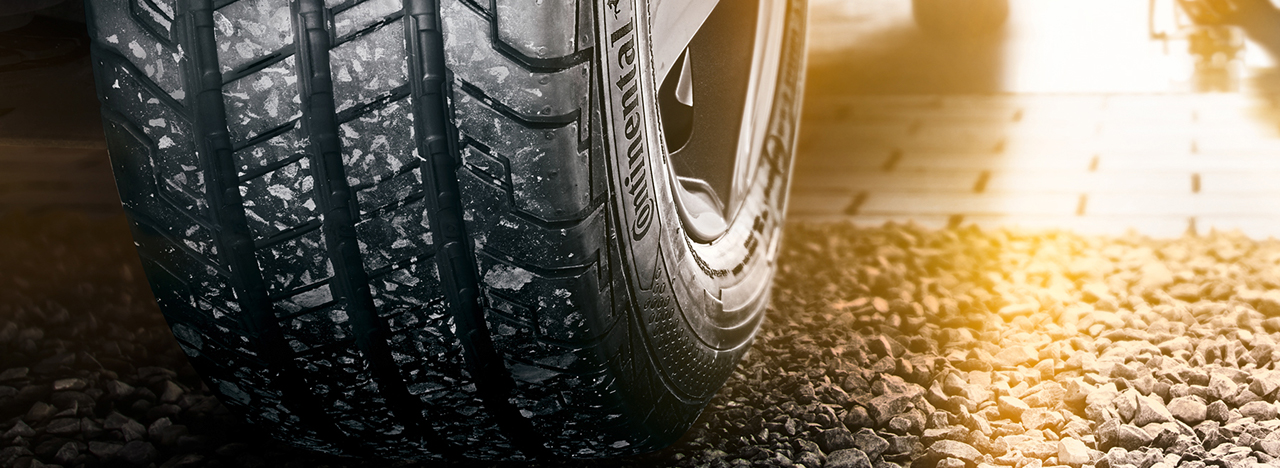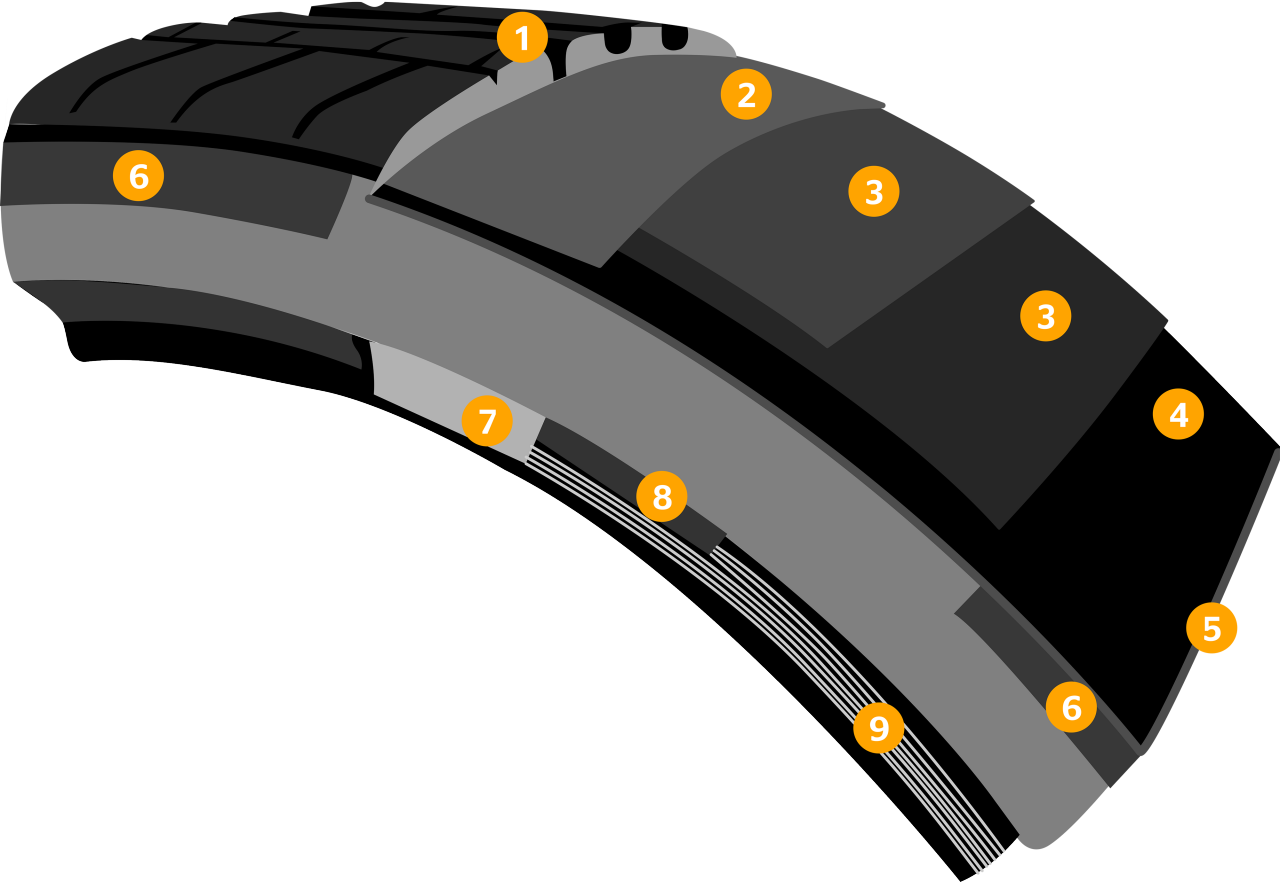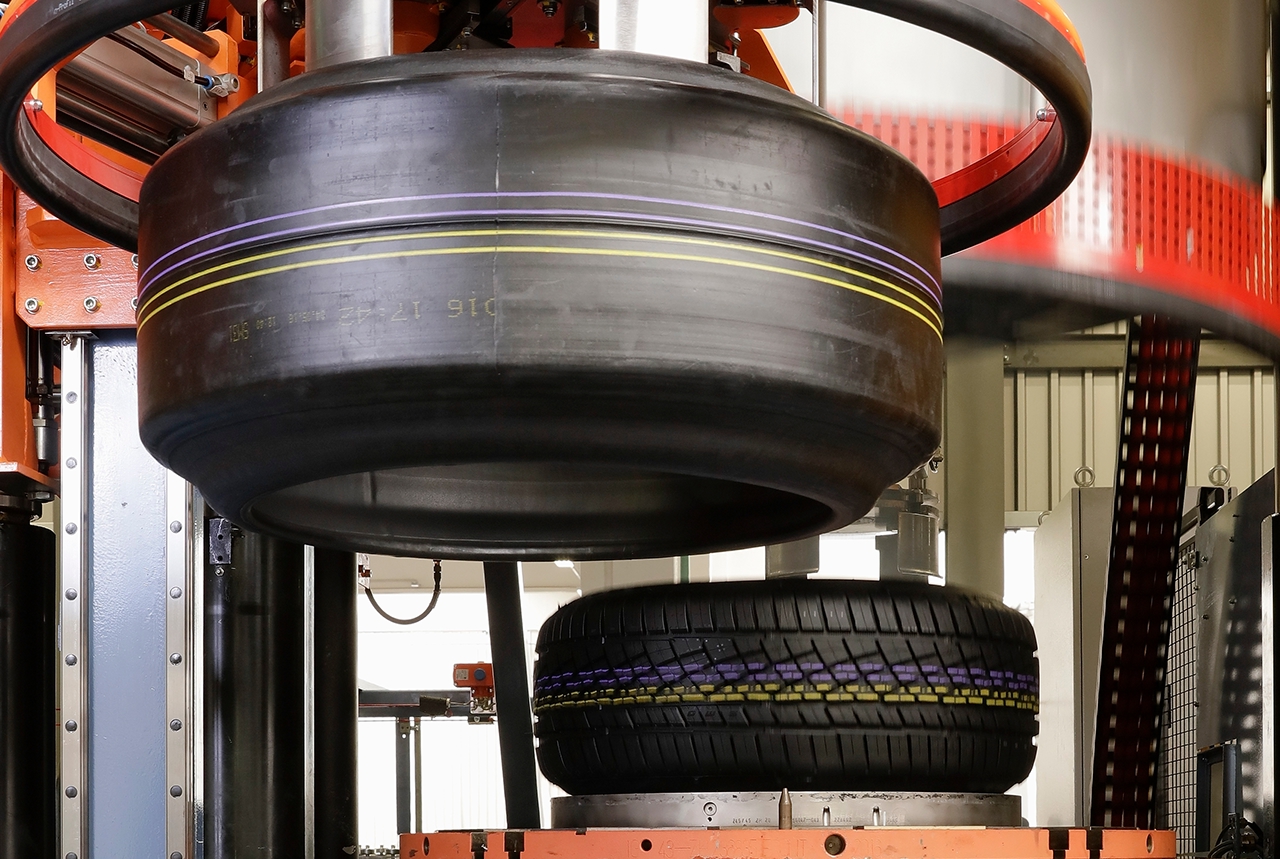
Visit Continental Tires in your country for local vehicle fitment
# Tire Basics
Tire components
An inside look at the components that make up modern car tires
Modern passenger car tires have a complex structure. The rubber tires we drive on today have been in the making for over a century. Continental has played a major role in the development of today’s steel-belted radial tires, improving tire design and function. Read on to discover all the different components in modern tires.
Tire components can be grouped into two main structural elements: The tread and belt assembly and the casing. These elements consist of several layers.

Starting at the road surface and working our way to the core of the tire, let’s take a look at the individual components. We’ll also discover what role these components play.

Tread: Keeping you on the road
Let’s start with the outer layers that make up the tread and belt of the tire. This principally rubber component envelops the casing and provides low rolling resistance, optimum handling, a long life and good gas mileage.
1. Tread Pattern. The tread establishes the connection to the road and consits of a special rubber compound and the individual tire pattern. The tire tread has three areas:
- Cap: This is the part of your tire that’s most in contact with the road. It provides grip on all road surfaces, wear-resistance and directional stability.
- Base: Underneath the cap, the base reduces rolling resistance and damage to the tire’s internal structure – the casing.
- Shoulder: At the outer edges of the tread, this area forms an optimal transition from the tread to the sidewall of the tire.
Continental’s contribution. In 1904, Continental was the first tire manufacturer to introduce a tread pattern to the pneumatic tires of the time.
2. Winding bandage. Directly unter the tread is the winding bandage. It consists of nylon threads embedded in rubber. It improves driving characteristics at high speeds. Imagine gathering a length of twine back into a ball, coiling it around and around. The winding bandage is a little like this. They consist of a single, strong cord of nylon, embedded in rubber. This cord spirals around the circumference of the tire, from one side to the other, without overlapping.
Continental’s contribution. A woven linen fabric embedded in rubber used to perform this function. But the crossed threads would rub against each other, resulting in a shorter tire life. In 1923, Continental introduced a new cord fabric. This fabric (described above) featured cords running in one direction held in place by supporting threads, embedded in rubber. Tires incorporating the new fabric lasted much longer.
3. Steel cord belt. High-strength steel wires (cords) form the next layer, the steel cord belt layer. They give the tire shape and strength, optimize rolling resistance and mileage.
Casing: Inside your tire
Now let’s discover the interior of the tire, known as the casing or carcass. The casing cushions the tire and contains air – functioning like an inner tube. It’s the air – not the tire itself – that carries the load. That's why inflation pressure is so important. Anyone who has ever had a flat tire knows this well!
4. Textile carcass. The load-bearing framework of the tire, the carcass, consists of a textile fabric based on rubberized fibers. This textile carcass regulates the internal pressure together with the inner layer.
5. Inner layer. The inner layer ensures airtightness and is made of synthetic rubber.

Tire bead: Connecting your tire to your wheel
Part of the casing, the tire bead component makes up the edge of the tire that sits securely on the wheel groove. It’s here that the tire is held in place on the wheel thanks to air pressure. The bead is made up of three parts.
7. Tire bead, 8. Core profile, 9. Steel core
The steel core and the core profile form the tire bead. This ensures tire seating on the rim, safe handling and driving comfort.
Read more here about how these components come together in the tire-building process.
What´s in your tires?
It's easy to take your tires for granted, but that black ring on the wheel of your car contains so much more than just plain rubber. In actual fact, it’s a complex blend of different rubbers – natural and synthetic – plus a whole host of other chemicals and construction materials. Expertly mixed and combined, our rubber compounds are sophisticated enough for a variety of driving conditions.
On average, a modern tire on a passenger car will contain up to 25 components and as many as 12 different rubber compounds. It all starts with natural rubber extracted from special trees grown in large plantations. This liquid (latex) coagulates with acid, is cleaned with water and pressed into bales.
Synthetic rubber, meanwhile, is created in a separate process using a mix of chemicals in the laboratory. During the manufacturing stage, these bales (both natural and synthetic) are cut up, weighed, and mixed with other ingredients according to precise recipes.

Textiles used for reinforcement
The textile industry supplies base materials (rayon, nylon, polyester and aramid fibers) for the manufacture of cords which serve as a reinforcing material.
Steel for strength
The steel industry supplies high-strength steel. This serves as the raw material for the manufacture of steel belts (steel cord) and bead cores (steel wire).
Read more here about these components come together in the tire-building process.
By the numbers
We can also look at the amount of materials used. Let’s take a look at what’s in one of Continental’s most popular summer models.*
- Rubber (natural and synthetic) 41%
- Fillers (carbon black, silica, carbon, chalk…) 30%
- Reinforcing materials (steel, polyester, rayon, nylon) 15%
- Plasticizers (oils and resins)¹ 6%
- Chemicals for vulcanization (sulfur, zinc oxide…) 6%
- Anti-ageing agents and other chemicals 2%
Of course, a different compound of materials provides different properties for different tires. The precise mix of ingredients matters.
* 205/55 R 16 91V ContiPremiumContact 5
¹ As of 2010 stringent mandatory limits are in effect in the EU explicitly for plasticizers classed as harmful to health. Thanks to the use of alternative types of oil, Continental tires remain well below these limits.
Materials to suit the season
The mix of materials used in a tire will depend on its purpose. The soft compounds in summer tires become hard below 7 °C, compromising grip. But winter tires offer special technology and a tire rubber composition that keeps them flexible and helps maintain grip – ensuring top performance, even in low temperatures. Living in a mild climate? All-season can provide an ideal solution.
Materials for quiet comfort
ContiSilent is a noise-reducing technology developed by Continental. It reduces interior noise on all road surfaces. How? ContiSilent tires feature a polyurethane foam absorber attached to the inner surface of the tread area with an adhesive. Regardless of the temperature, the structure of the foam stays intact. Even at high speeds, the ContiSilent absorber reduces road noises inside the vehicle by up to 9 dB(A).
Tried, tested and guaranteed
Manufactured from only the highest quality materials, Continental tires set high standards – particularly when it comes to safety. Before any Continental innovation goes into production, it is tested intensively. Testing is carried out on every winter and summer tire. This is done under all kinds of weather and road surface conditions, using the most modern testing methods and measuring technology.
Every test has one simple purpose: making driving safer.
Related content
-
 2024/10/17There are three things to know when buying new tires for your car – the size, speed rating, and load index – and all this information is easy to find.Tire sizeRead more
2024/10/17There are three things to know when buying new tires for your car – the size, speed rating, and load index – and all this information is easy to find.Tire sizeRead more -
 2024/10/17A modern tire is made from many components. Follow the tire manufacturing process step by step, from raw materials to finished tires.Tire productionRead more
2024/10/17A modern tire is made from many components. Follow the tire manufacturing process step by step, from raw materials to finished tires.Tire productionRead more -
 2024/12/10Markings on the tire sidewall are shorthand for a wealth of information including the load index, speed rating, tire size, construction, and more.Tire markingsRead more
2024/12/10Markings on the tire sidewall are shorthand for a wealth of information including the load index, speed rating, tire size, construction, and more.Tire markingsRead more